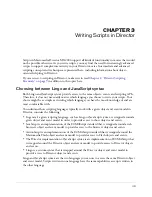
Object-oriented programming with Lingo
63
This statement uses the following elements:
•
variableName
is the variable you are placing the timeout object into.
•
timeout
indicates which type of Lingo object you are creating.
•
timeoutName
is the name you give to the timeout object. This name appears in the
timeOutList
. It is the
#name
property of the object.
•
new
creates a new object.
•
intMilliseconds
indicates the frequency with which the timeout object should call the
handler you specify. This is the
#period
property of the object. For example, a value of 2000
calls the specified handler every 2 seconds.
•
#
handlerName
is the name of the handler you want the object to call. This is the
#timeOutHandler
property of the object. You represent it as a symbol by preceding the name
with the
#
sign. For example, a handler called
on accelerate
would be specified as
#accelerate
.
•
targetObject
indicates which child object’s handler should be called. This is the
#target
property of the object. It allows specificity when many child objects contain the same handlers.
If you omit this parameter, Director looks for the specified handler in the movie script.
The following statement creates a timeout object named
timer1
that calls an
on accelerate
handler in the child object
car1
every 2 seconds:
-- Lingo syntax
myTimer = timeOut("timer1").new(2000, #accelerate, car1)
To determine when the next timeout message will be sent from a particular timeout object, check
its
#time
property. The value returned is the point in time, in milliseconds, when the next
timeout message will be sent. For example, the following statement determines the time when
the next timeout message will be sent from the timeout object
timer1
and displays it in the
Message window:
-- Lingo syntax
put(timeout("timer1").time)
Using timeOutList
When you begin creating timeout objects, you can use
timeOutList
to check the number of
timeout objects that are active at a particular moment.
The following statement sets the variable
x
to the number of objects in
timeOutList
by using the
count
property.
-- Lingo syntax
x = _movie.timeoutList.count
You can also refer to an individual timeout object by its number in the list.
The following statement deletes the second timeout object in
timeOutList
by using the
forget()
method.
-- Lingo syntax
timeout(2).forget()
Summary of Contents for DIRECTOR MX 2004-DIRECTOR SCRIPTING
Page 1: ...DIRECTOR MX 2004 Director Scripting Reference...
Page 48: ...48 Chapter 2 Director Scripting Essentials...
Page 100: ...100 Chapter 4 Debugging Scripts in Director...
Page 118: ...118 Chapter 5 Director Core Objects...
Page 594: ...594 Chapter 12 Methods...
Page 684: ...684 Chapter 14 Properties See also DVD...
Page 702: ...702 Chapter 14 Properties See also face vertices vertices flat...
Page 856: ...856 Chapter 14 Properties JavaScript syntax sprite 15 member member 3 4...
Page 1102: ...1102 Chapter 14 Properties...






























